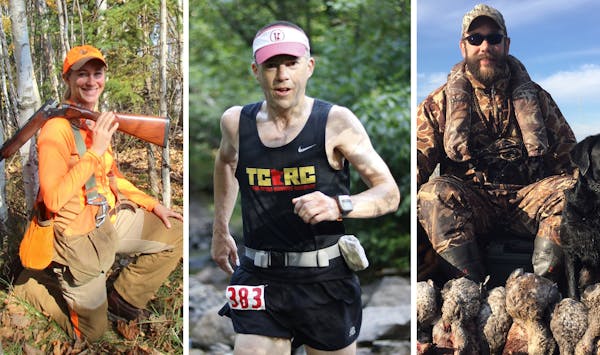Wednesday on these pages, outdoors writer Tony Kennedy interviewed Department of Natural Resources big game coordinator Adam Murkowski. Discussed was the deer management plan the DNR will develop over the next couple of years and, part and parcel to it, membership on the advisory committee, now being formed, that will aid the agency in that effort.
In the interview, Murkowski confirmed that DNR leadership has not in the first round of committee designees selected Minnesota Bowhunters Inc. President Brooks Johnson to serve on the deer-plan advisory panel.
Johnson, as is widely known, isn't a favorite of the DNR, because in recent years he has repeatedly questioned the direction, or lack thereof, of Minnesota deer management.
Yet Johnson's needling ultimately served a greater good, for which most state deer hunters are thankful: It helped prompt the Legislature to review DNR deer management, and a report issued earlier this year said whitetail governance in the state should transpire according to a well-devised plan.
Whether such a plan would have forestalled the dramatic downturn in recent years of deer numbers across much of the state is unknown. Perhaps even with such a blueprint in hand, the DNR would have distributed antlerless permits too liberally, as it did in some recent years, allowing individual hunters in certain areas to kill as many as five deer, and not only in the metro.
In fairness, back-to-back inclement winters also prompted deer declines in some parts of the state. But population regressions caused by extreme cold and deep snow generally were limited to portions of the far north, laying bare the fib that bad weather alone left some hunters, including DNR Commissioner Tom Landwehr, without venison on the table for three or more years running.
Yet the broader point is less about deer management than about the DNR's antipathy toward rabble-rousers in general — an attitude that serves the DNR poorly, and undercuts its own best interests.
The agency and its staff, after all, and its initiatives have to a large degree been underwritten over many years by the efforts of Minnesotans who, like Johnson, base their opinions not at all on who might be offended by their passion-fueled comments but by what resource policies they believe are correct, based oftentimes on their firsthand experiences in the field.
The Legacy Act, passed by voters in 2008, and which infuses various DNR divisions with tens of millions of dollars annually, is a case in point.
The DNR didn't lead the decadelong fight to place the Legacy Amendment idea on the ballot. (In fact, it and other state agencies are forbidden to take such advocacy positions.) That nitty-gritty work was left to the rabble-rousers among DNR constituents, most of whom were driven more by a hunger for ducks, wetlands and clean water than for concern about whose toes might be stepped on, and how hard.
Additionally, Minnesota today has an ever-expanding population of wild turkeys, thanks to a handful of gobbler hunters in the 1960s who called the DNR's bluff when it said turkeys were a goner in this state, not soon to be revived.
And: If four guys from Albert Lea hadn't tired in the 1970s of watching wetlands being drained in southern Minnesota, the state today might not have a duck stamp — or the Minnesota Waterfowl Association.
Ditto the pheasant stamp, formation of Pheasants Forever and, largely, development of the original 1985 Conservation Reserve Program, the concept and lobbying for which were paid for by Minnesota ringneck hunters in the early 1980s.
Yet another example of DNR outsiders benefiting the agency, and the state as a whole, is the rebirth of dove hunting in Minnesota, credit for which can largely be assigned to a small group, including the late Sen. Charlie Berg of Chokio, who were less concerned with protocol than results.
More recently, the rabble-rousing of Gov. Mark Dayton prodded the DNR to organize the state's first Pheasant Summit and, from it, a state ringneck recovery plan.
Dayton also prodded the DNR to move the needle on the agency's steady-as-she goes Mille Lacs walleye management program, sparking something akin to action, including the first stocking of walleye fry in the lake.
Some in the DNR will disagree their agency is dependent, at times, on outside influences, including rabble-rousers and their ilk, for vitality and direction.
History says otherwise.
The irony is that, the very people the DNR needs are sometimes the same ones it pushes away, Brooks Johnson among them.
Dennis Anderson • danderson@startribune.com
Anderson: Anglers protesting tough new Mille Lacs rules are wrong

Anderson: Courts, not politicians, should rule on Red Lake, White Earth lands

Anderson: Multimillion windfall gets invasive carp deterrent moving
![A young whitetail deer searches for food as another blanket of snow coats the arrowhead. ] Minnesota -State of Wonders, Arrowhead in Winter BRIAN PETE](https://arc.stimg.co/startribunemedia/WK32UWWY6FKNWJUIYCJ6ZPT4AU.jpg?h=91&w=145&fit=crop&bg=999&crop=faces)
Anderson: In NE Minnesota, DNR staff, habitat and deer all decline


